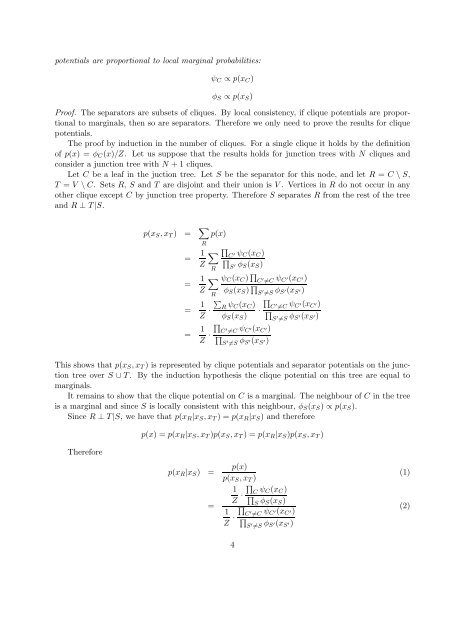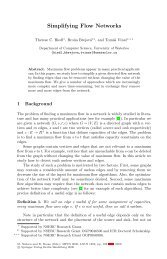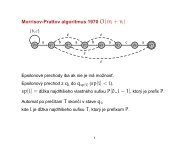1 The Junction Tree Algorithm (Hugin algorithm) Chapter 16(17 ...
1 The Junction Tree Algorithm (Hugin algorithm) Chapter 16(17 ...
1 The Junction Tree Algorithm (Hugin algorithm) Chapter 16(17 ...
Create successful ePaper yourself
Turn your PDF publications into a flip-book with our unique Google optimized e-Paper software.
potentials are proportional to local marginal probabilities:<br />
ψC ∝ p(xC)<br />
φS ∝ p(xS)<br />
Proof. <strong>The</strong> separators are subsets of cliques. By local consistency, if clique potentials are proportional<br />
to marginals, then so are separators. <strong>The</strong>refore we only need to prove the results for clique<br />
potentials.<br />
<strong>The</strong> proof by induction in the number of cliques. For a single clique it holds by the definition<br />
of p(x) = φC(x)/Z. Let us suppose that the results holds for junction trees with N cliques and<br />
consider a junction tree with N + 1 cliques.<br />
Let C be a leaf in the juction tree. Let S be the separator for this node, and let R = C \ S,<br />
T = V \ C. Sets R, S and T are disjoint and their union is V . Vertices in R do not occur in any<br />
other clique except C by junction tree property. <strong>The</strong>refore S separates R from the rest of the tree<br />
and R ⊥ T |S.<br />
p(xS,xT) = <br />
p(x)<br />
= 1<br />
Z<br />
= 1<br />
Z<br />
R<br />
<br />
<br />
C<br />
R<br />
<br />
R<br />
′ ψC(xC)<br />
<br />
S ′ φS(xS)<br />
ψC(xC) <br />
C ′ =C ψC ′(xC ′)<br />
φS(xS) <br />
<br />
R ψC(xC)<br />
S ′ =S<br />
<br />
C ′ =C<br />
φS ′(xS ′)<br />
= 1<br />
Z ·<br />
ψC ′(xC ′)<br />
· <br />
φS(xS) S ′ =S φS ′(xS ′)<br />
= 1<br />
Z ·<br />
<br />
C ′ =C ψC ′(xC ′)<br />
<br />
S ′ =S φS ′(xS ′)<br />
This shows that p(xS,xT) is represented by clique potentials and separator potentials on the junction<br />
tree over S ∪ T. By the induction hypothesis the clique potential on this tree are equal to<br />
marginals.<br />
It remains to show that the clique potential on C is a marginal. <strong>The</strong> neighbour of C in the tree<br />
is a marginal and since S is locally consistent with this neighbour, φS(xS) ∝ p(xS).<br />
Since R ⊥ T |S, we have that p(xR|xS,xT) = p(xR|xS) and therefore<br />
<strong>The</strong>refore<br />
p(x) = p(xR|xS,xT)p(xS,xT) = p(xR|xS)p(xS,xT)<br />
p(xR|xS) =<br />
=<br />
p(x)<br />
p(xS,xT)<br />
1<br />
Z ·<br />
<br />
C ψC(xC)<br />
<br />
S φS(xS)<br />
1<br />
Z ·<br />
<br />
C ′ =C ψC ′(xC ′)<br />
<br />
S ′ =S φS ′(xS ′)<br />
4<br />
(1)<br />
(2)









